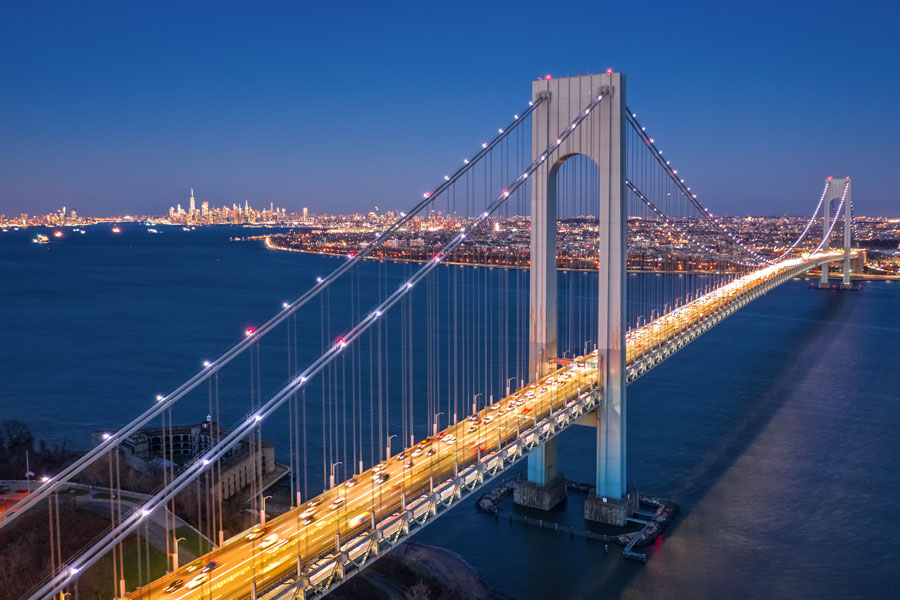Verrazzano-Narrows Bridge

The Verrazzano-Narrows Bridge is one of New York City’s most recognizable landmarks and a vital link in the region’s transportation network. Spanning the Narrows between Staten Island and Brooklyn, the suspension bridge opened in 1964 and was the longest in the world at the time. Today, it remains a critical connection for drivers traveling between Long Island, Staten Island, and points south, including New Jersey.
History
- Planning & Naming: Named after Italian explorer Giovanni da Verrazzano, who was the first European to enter New York Harbor in 1524.
- Construction: Built between 1959 and 1964 under the leadership of Robert Moses, the bridge was an engineering marvel of its day.
- Opening: Officially opened on November 21, 1964, with the upper deck completed first; the lower deck was added in 1969 to handle increased traffic.
- Notable Fact: For over 50 years, the bridge’s name was misspelled “Verrazano” (with one “z”) until legislation corrected it in 2018.
Design & Features
- Bridge Type: Suspension bridge.
- Total Length: 13,700 feet (2.6 miles), making it the longest bridge in New York City.
- Main Span: 4,260 feet, which was the world’s longest suspension span when completed.
- Towers: Each tower stands 693 feet tall, taller than the Washington Monument.
- Roadway: Two decks carrying 13 lanes of traffic (7 on the upper, 6 on the lower).
- Tolling: Cashless tolling via E-ZPass or Tolls by Mail.
Importance for Long Island Travelers
The Verrazzano-Narrows Bridge is a vital crossing for Long Islanders heading to:
- Staten Island & New Jersey – providing direct access to the Staten Island Expressway and the Goethals Bridge, Outerbridge Crossing, and Bayonne Bridge.
- Southbound Routes – a key link for travelers heading toward the New Jersey Turnpike and points south along the I-95 corridor.
- Brooklyn & Manhattan – the bridge connects directly into the Gowanus Expressway (I-278), serving as a route toward Manhattan or deeper into Brooklyn.
For many Long Island drivers, it’s the preferred way to reach New Jersey and beyond without passing through Manhattan.
Nearby Landmarks
- Brooklyn Side: Bay Ridge, Fort Hamilton, and Shore Road Park.
- Staten Island Side: Fort Wadsworth, one of the oldest military installations in the United States, now part of the Gateway National Recreation Area.
Q&A – Verrazzano-Narrows Bridge
Q: Why is the Verrazzano-Narrows Bridge famous?
A: It was the longest suspension bridge in the world when it opened and remains a major New York landmark.
Q: Does the bridge connect directly to Long Island?
A: Indirectly. The bridge connects Staten Island to Brooklyn, where drivers can continue east onto the Belt Parkway and Long Island highways.
Q: How much does the toll cost?
A: Tolls vary by E-ZPass, vehicle type, and residency discounts. Staten Island residents receive special reduced rates.
Q: Can pedestrians or bicycles cross the Verrazzano-Narrows Bridge?
A: No, the bridge is closed to pedestrian and bicycle traffic, except during special events like the New York City Marathon.
Bridge Snapshot
| Feature | Details |
|---|---|
| Opened | 1964 (upper deck), 1969 (lower deck) |
| Bridge Type | Suspension |
| Main Span | 4,260 feet |
| Total Length | 13,700 feet (2.6 miles) |
| Lanes | 13 total (upper and lower decks) |
| Operator | MTA Bridges & Tunnels |
| Primary Connection | Brooklyn (I-278 Gowanus Expressway) ↔ Staten Island (I-278 Staten Island Expressway) |
The Verrazzano-Narrows Bridge is more than just an engineering achievement – it is a crucial link connecting Long Island with Staten Island, New Jersey, and the broader interstate highway system. For commuters, truckers, and long-distance travelers, it remains one of the busiest and most essential crossings in New York City. Its iconic towers and sweeping span across the Narrows also make it one of the city’s most photographed landmarks, symbolizing the gateway between New York Harbor and the Atlantic Ocean.

